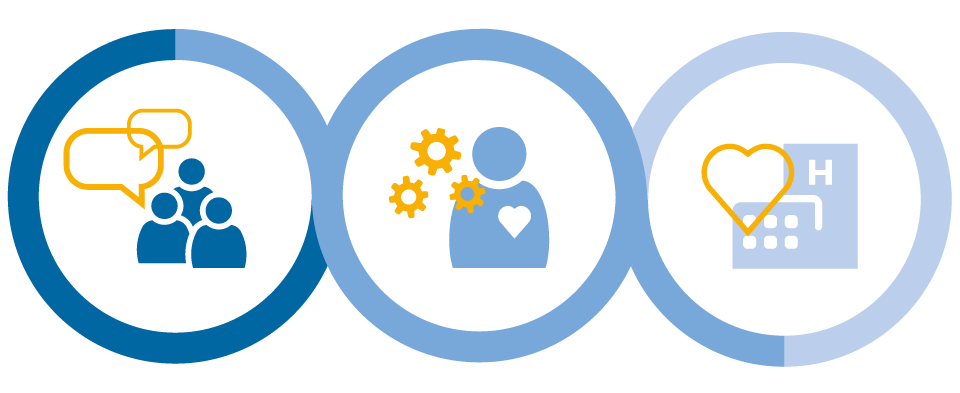Using AI and Data to Target Addiction
Using AI and Data to Target Addiction
Cognizant is exploring using an AI solution to flag at-risk patients, combining data both from medical records and notes from in-person interactions with physicians. The technology uses text analysis and data to search for the patterns and commonalities associated with drug seeking behaviors, coupled with a learning component that allows for improvements. Physicians can then intervene with patients before addiction takes hold. This preventative approach has the potential to reap concrete health and monetary benefits.
The full case study can be viewed below.
E-Prescribing as a Tool to Fight the Opioid Epidemic
E-Prescribing as a Tool to Fight the Opioid Epidemic
Surescripts shares the results of a new initiative in Maine requiring electronic prescribing for opioids. Use of e-prescribing technology (E-Prescribing for Controlled Substances or EPCS) has greatly increased, demonstrating how legislation can be an important tool for driving technology adoption. Various benefits of EPCS in regards to the opioid crisis are highlighted. Tracking prescription helps reveal patterns of use amongst patients and leniency amongst providers. Security is enhanced by reducing fraud associated with paper or oral prescriptions. The article emphasizes that EPCS is simply one tool in what is likely to ultimately be a multi-pronged solution to the opioid crisis.
The full article can be viewed here
Prior Authorization and Supply Limit Changes for Short-Acting Opioids
Following the Centers for Disease Control and Prevention (CDC) declaring a national opioid epidemic and Governor Scott claiming the opioid epidemic in Florida a statewide emergency, Florida Blue is introducing prior authorization and supply limits for use of short-acting opioids for your opioid naïve patients. They're making the changes to ensure appropriate use of opioid analgesics for members suffering from chronic pain, and to protect both patients and their families from the risk of opioid abuse, misuse and diversion, while providing continued access to opioid medications when appropriate.
CMS Leverages Medicaid Program To Combat The Opioid crisis
Today, the Centers for Medicare & Medicaid Services CMS released guidance aimed at building on their commitment to partner with states to ensure that they have flexibilities and the tools necessary to combat the opioid crisis. This new guidance provides information to states on the tools available to them, describes the types of approaches they can use to combat this crisis, ensures states know what resources are available, and articulates promising practices for addressing the needs of beneficiaries facing opioid addiction. Notably, CMS released an Informational Bulletin that provides states with information they can use when designing approaches to covering critical treatment services for Medicaid eligible infants with Neonatal Abstinence Syndrome (NAS). Additionally, CMS issued a letter to states on how they may best use federal funding to enhance Medicaid technology to combat drug addiction and the opioid crisis.
CMS Opioid Roadmap
Although some progress has been made in efforts to combat the opioid epidemic, the latest data from the Centers for Disease Control and Prevention indicate the crisis is not slowing down. However, it is important for their beneficiaries across the country to know that the Centers for Medicare & Medicaid Services (CMS) is exploring all of their options to address this national crisis.
Getting Started with Electronic Prescribing of Controlled Substances
The videos and digital tools on www.getEPCS.com make it easy for users to learn what to do to get their practice up and running with electronic prescribing of controlled substances (EPCS).
Value & Reimbursement Roundtable Summary
 The conversation in the Value & Reimbursement Roundtable began by looking at value-based care through the lens of accelerators and barriers. Pre-authorizations are perceived as a barrier to care because many physicians find that the process slows downs their clinical workflow, is costly, and burdensome. Participants also thought the term ‘pre-authorization’ was inherently flawed, stating that the name of the process should more accurately reflect its purpose. Pre-authorizations represent an evidence-based review of coverage determination.
The conversation in the Value & Reimbursement Roundtable began by looking at value-based care through the lens of accelerators and barriers. Pre-authorizations are perceived as a barrier to care because many physicians find that the process slows downs their clinical workflow, is costly, and burdensome. Participants also thought the term ‘pre-authorization’ was inherently flawed, stating that the name of the process should more accurately reflect its purpose. Pre-authorizations represent an evidence-based review of coverage determination.
The group stated that insurance companies were often a barrier to care and believed the coverage determination process could be automated. Through collaboration with payers and technology companies, roundtable participants envisioned a virtually painless coverage determination process and began planning to implement a digital pilot program that would create a seamless relationship between payers and providers.
This coverage determination system could instantly accept or deny claims and report back to providers the reasons for denial, such as a health plan not offering a procedure or medical device, inconsistencies in a patient’s medical records, or unacceptable test results. The goal is to reduce the burden on the clinical workflow and provide a new type of communication between physicians and patients. With instantaneous insurance coverage information, patients and physicians would be able to craft a better care plan, at the point of care. The group decided three criteria were needed to accelerate the development of a universal value-based care system:
Evidence-based criteria applied in a clinical workflow
A set of “must-haves” that determine the appropriate treatment (procedures, medical devices, services, medications, etc.) for a patient
Harmonization of payer outcome measures
An outcome measure (such as mortality, readmission rates, and patient experience) that is standardized, represents a change in health status of an individual, and recorded after a provider visit
Harmonization for registry submissions
A standardized registry for the various types of value-based care criteria
PILOT: VALUE & REIMBURSEMENT
The digital pilot program took its first step when UnitedHealthcare physicians Dr. Sam Ho, Executive Vice President and Chief Medical Officer, and Dr. Anthony Nguyen, Senior Vice President of Population Health, sent the criteria associated with UnitedHealthcare’s coverage of wheelchairs, sleep apnea studies, and radiology related to lower back pain to Jon Zimmerman, Vice President & General Manager at GE Healthcare.
GE Healthcare will now focus on the creation of technology that can be used to automatically accept or deny claims from payers using evidence-based criteria. From a technological standpoint, Zimmerman believes the process can be created and automated within a few weeks. The key to its success and adoption will be the selection of the appropriate pilot facility. The hospital chosen cannot be too big or small to demonstrate that an automated coverage determination process is feasible in all facilities. Before the pilot occurs, GE will produce a webinar on how to incorporate this new standard into the Electronic Health Record (EHR).
POLICY PLAN: VALUE & REIMBURSEMENT
The Value & Reimbursement Roundtable policy plan calls for eHealth Initiative’s Policy Steering Committee to support the American Hospital Association’s (AHA) letter to increase broadband nationwide, especially in rural areas. AHA supports the increase in data caps and will advocate for this step in the letter. eHealth Initiative also commented on the Trusted Exchange Framework and Common Agreement (TEFCA) and sent a letter on February 20 to make comments on the voluntary data registry.
The most important piece of the value and reimbursement policy plan in 2018 is to educate lawmakers on digital healthcare topics and the issues the private sector is dealing with around value-based care and reimbursements. eHealth Initiative is planning to share the American College of Radiology’s (ACR) Appropriateness Criteria, which uses evidence-based guidelines to assist physicians and other care professionals in making the best imaging and treatment decisions. The plan is to share how technology, the coverage determination pilot, and tools such as the Appropriateness Criteria enhance value-based care.
Workflows to Improve Patient Experience Roundtable Summary
 The key themes that emerged in the Workflows to Improve Patient Experience Roundtable were enabling relationships through technology; building relationships between stakeholders; appropriate care in all healthcare settings; navigation and coordination that solicits input from patients; and value across the spectrum (economic, quality of care and life, efficiency in relationships, support groups, self-care, shared decision making, parity).
The key themes that emerged in the Workflows to Improve Patient Experience Roundtable were enabling relationships through technology; building relationships between stakeholders; appropriate care in all healthcare settings; navigation and coordination that solicits input from patients; and value across the spectrum (economic, quality of care and life, efficiency in relationships, support groups, self-care, shared decision making, parity).
The group choose three priority areas to address:
- Encourage industry to transform current portals from transaction based towards platforms that co-produce health and maximize relationships.
- Tie patient engagement to the business cases that matter to all healthcare stakeholders—growth, retention, efficiency, and empathy—so that reimbursement is not the only consideration when strategic health information technology (HIT) decisions are made.
- Advise and convene adjacent industries via eHealth Initiative to facilitate access to healthcare thought leaders and inform HIT leadership. These adjacent industries could be strong in personal technologies, platforms, consumer products, consumer services, entering healthcare or wellness (for example Apple, Mint, Amazon, Android), and include companies from areas of healthcare emerging as HIT stakeholders, such as genomic and research platforms (for example Seqster and Verily).
TRANSFORMING CURRENT PORTALS & POLICY PLAN
In the transformation of current portals, roundtable participants want vendors and providers to expand beyond the ‘plumbing’ to enhance methods and to move from one-way transactions to care team exchanges that are respectful and encouraging. Additionally, the meaning of “care team” should be defined by the patient, moving beyond the licensed provider. Transparency around price, quality, and experience is important. This priority requires the addition of patient advocacy groups to the collaborative and in inventory of who the advocacy groups are on a national and regional level.
The policy plan to transform portals convenes stakeholders to draft policy statements on strategies that allow for innovation and self-care in medical devices and continued diligence and guidance in the following areas:
- Enhance Meaningful Use by liberating the data, adding new stakeholders, and reducing reporting requirements and administrative over-burden
- Create a standardized definition for telehealth and bi-partisan support for the Triple Aim, because telehealth contributes to better outcomes and lower costs
- Co-sponsor The Chronic Care Act
- Create an even playing field for all providers, payers and contract administrators so that paper/faxes can be eliminated and equal communication for both fee for service and value-based payment administration is achieved.
TYING PATIENT ENGAGEMENT TO THE BUSINESS CASES & POLICY PLAN
This priority has a guiding principle that mandates its work relates to a business case and data flow that supports productivity and enhances national growth. It requires new constituents, such as home health services, patient monitoring companies, device manufacturing, and pharma and provides opportunities for these new stakeholders. Policy goals include:
- Policy to consider a quadruple aim — Cost, Quality, Outcomes, and Productivity. Productivity as a measure can counteract “burden” by measuring regulation through this lens, for providers, patients, and all stakeholders
- Improve national productivity by 3%
- Continue with incentives that drive collaboration in care
- Educate policy leaders on the business case for patient engagement
- Connect issues to patient data flow and gaps in care and coordination to improve efficiency
INVITE ADJACENT INDUSTRIES & POLICY PLAN
Goal: Become the go-to organization adjacent industries look to for knowledge about healthcare
- Convene a group of adjacent industries
- Generate a whitepaper and webinars
- Create a journey map and persona for the industries to help inform the ideal engagement and relationship platform
- Prepare a proposal for non-covered entity relationships to patient data, in a secure and patient driven manner, including consent frameworks that are easy for patients to use and encouraging responsible use of patient information
- Encourage universal broadband access
- Educate and encourage industry knowledge and awareness of 5G
- Agreeable framework for data ownership & use
Technology & Analytics Roundtable Summary
THE TECHNOLOGY & ANALYTICS ROUNDTABLE
The goal of the Technology & Analytics Roundtable was to recommend 3-5 practical, patient-centric outcomes that would improve care for patients with chronic conditions through technology, analytics, and interoperability. Preliminary discussions revolved around closing gaps in data, removing barriers to sharing information, educating patients and providers about consent around data sharing, potential uses for labs and lab data, incentivizing patients and providers to share data, remote patient monitoring, and patient engagement.
The group split into three sub-groups, consumers, providers (including clinicians, labs, and pharmacy), or those working with the actual technology and data, to further narrow down tools for effective chronic condition management. The premise was that it is best to build technology around the needs and expectations of consumers and providers. The patient and provider sub-groups independently determined that patients and providers had the following expectations:
Know me: Physicians should already have access to patient data without needing the patient to repeat basic information. For example, medications, past surgeries, etc.
Guide me: Information that will guide patient care should always be readily available to both physicians and patients, including the who, what, when, where, and why of diagnoses, prescriptions, and care plans. Physicians are also interested in peer comparison reports.
Accessibility: Patients and physicians expect reasonable access to patient data. Patients want access on their terms. For example, they want to be able to see lab results in a patient portal and then to ask questions about the results.
Financial Transparency: Patients and clinicians want to be knowledgeable about the tests, services, and devices covered by health plans. Patients are particularly interested in total out-of-pocket costs and want suitable, and affordable, alternatives to services that are not covered.
The technology sub-group focused on offering decisional support systems; analytics; integrating data into the provider’s workflow, including relevant data sets, claims and medication information; and any information collected outside the walls of a traditional clinical setting, such as social determinants of health data and patient generated health data.
KEY FOCUS AREAS
The overlapping priorities identified by the three sub-groups were as follows:
- Patient consent
- Establishment of data needs & data in the correct locations
- Expanding current success through other pilots
- Provider & consumer incentives
- Financial transparency between provider and patient
- Education/awareness
- Standards of care
- Condition management bundles (i.e. pre-approval)
- Gaps in claims data reported back to care team
- Measurable benchmarks
- Remote patient monitoring
- Social Determinants of Health
The group identified three key focus areas:
- Automate and share patient consent information among providers
- Create seamless integration of data for patients with diabetes care
- Create a pilot to demonstrate how to streamline and integrate information for providers caring for patients with diabetes
The long-term goal of the pilot project is to create a facilitation process or platform, as well as a methodology and communication toolkit, create a model of engagement for long term use, and to have patients manage their chronic conditions better.
POLICY PLAN: TECHNOLOGY & ANALYTICS
- Constructively engage with the Administration on their regulatory reduction efforts.
- Support the FDA’s Software Precertification Pilot Program, a part of the Digital Health Innovation Action Plan, which streamlines the regulatory process for companies with a history of developing and testing quality programs.
- Explore relevant Centers For Medicare & Medicaid Services (CMS) reimbursement policies for certain remote patient medical device monitoring, such as glucose monitors.
- Continue to monitor and provide input on information blocking policies, including the anticipated Office of the National Coordinator for Health Information Technology (ONC) proposed rule, which will clarify the definition of information blocking and other issues.
- Consider a campaign and use case to get patients to understand the value of sharing data
- Research and evaluate states’ consent laws and encourage the federal government to nudge states towards changing consent forms to encourage patient sharing.
- Discuss standardization of patient consent forms, where states have the option to add additional consent requirements.
- Weave value-based payment themes into work and advocacy, such as CMS’ new voluntary episode payment model, Bundled Payments for Care Improvement Advanced (BPCI Advanced)
Direct Image Transfer: A Case Study
American College of Radiology explores how an Indianapolis hospital implements a radiology cloud for seamless image transfer among referring hospitals in a tri-state area.
